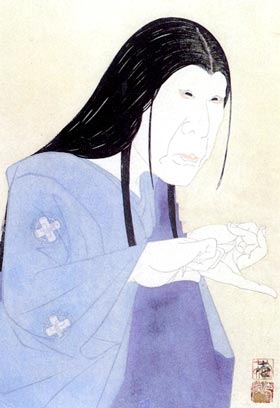| SUMIDAGAWA |
| Dance title | Sumidagawa |
| Authors | Yamazaki Shikô (lyrics) Kiyomoto Umekichi II (music) |
| History |
The Kiyomoto-based dance "Sumidagawa" was premiered in September 1919 at the Kabukiza. It was adapted for Kabuki from a Nô drama by Yamazaki Shikô with a musical accompaniment made by Kiyomoto Umekichi II. It was inspired by Russian ballets seen by Ichikawa Ennosuke II during his European study tour. The actor played the role of the wandering woman Hanjo-no-Mae, desesparately looking for her abducted son Umewakamaru along the Sumida River [casting]. |
| Key words |
Kiyomoto Omodaka Jûshu Shosagoto Sumidagawa Sumidagawamono Sumidagawa (Nô) |
| Summary |
A mad woman from Kyôto has been wandering the country in search of her young son who was stolen by a slave trader. On the banks of the Sumida River in Edo (present Tôkyô), she meets a ferry boatman. When she questions him about the name of the white birds flying over the river, he tells her that they are miyakodori, and quotes an ancient poem in which it is also called "bird of the capital". The poetic name of the bird reminds the woman of home, making her homesick. The boatman agrees to take her across the river and during the trip, she questions him about the crowd gathered near a small mound on the opposite bank. He explains that during the spring of the previous year, a boy was abandoned by a slave-trader and died there. The mound is his grave, and the people are holding a memorial service in honor of the first anniversary of his death. Before the boy died, he revealed that his family name was Yoshida and that he was from Kyôto. The woman realizes that it is the grave of her lost son, and she bursts into tears. The boatman comforts her, and together they pray for the repose of the boy's soul. In her grief, the mother imagines that she hears her son's voice calling out to her from the grave, but it is only the cry of the plover flying overhead announcing the coming of dawn. Then she thinks that she has caught a glimpse of him among the willow trees on the bank of the river, but it is only the shifting shadows of the trailing willow branches. All her illusions are shattered in the light of the rising sun. Source: Don Kenny |
 |
|
Nakamura Utaemon VI playing the role of the wandering woman Hanjo-no-Mae
in the dance-drama "Sumidagawa" in a print made by Tsuruya Kôkei |
|
|
| Contact | Main | Top | Updates | Actors | Plays | Playwrights | Programs | Links | FAQ | Glossary | Chronology | Illustrations | Prints | Characters | Derivatives | Theaters | Coming soon | News |